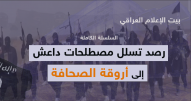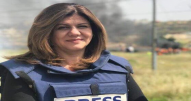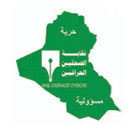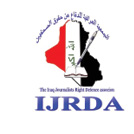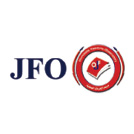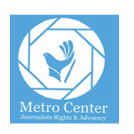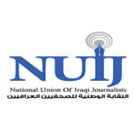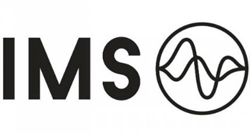Iraqi Media Coverage of Diyala Attack - Plays Upon Sensitive Sectarian Chord
الصفحة الرئيسية > تقارير الرصد الإعلامي > Iraqi Media Coverage of Diyala...
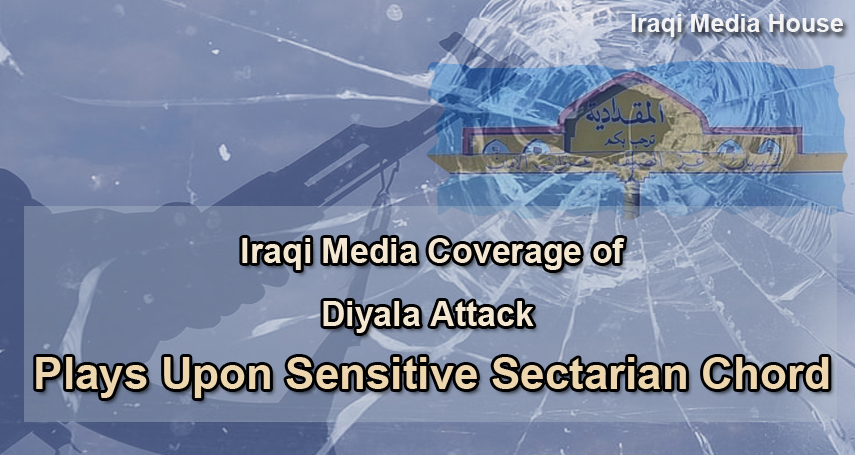
Iraqi Media Coverage of Diyala Attack
Plays Iraqi Media HouseUpon Sensitive Sectarian Chord
The Iraqi Media House ‘IMH’ monitors in its 58th report the local media coverage of the security crisis in the Muqdadiyah district, Diyala Governorate. This coverage came in the wake of the terrorist attack perpetrated by ISIS against the ‘Rashad’ village on the night of the 26th of October, 2021 and cropped dozens of lives and injuries.
In response, the Shiites launched vindictive attacks against the neighboring "Sunni" villages (Al-Rashad Al-Thaniya, Nahr Al-Imam, and Shouk Al-Reem). Attacks that resulted in dozens of deaths and injuries; hundreds of families were displaced, dozens of houses were burnt and flattened to the ground and fruitful orchards were bulldozed.
Such a tragic situation aroused fears of sparking a civil bloody strife on a much larger scale, particularly under the already existing political crisis in the country, where demonstrations challenged the integrity of the elections, rejected its results and demanded a manual recount of votes; and political opponents exchanged media battles on the social media.
That actually caused a wave of incitement against the ‘Sunni’ component. Explicit and open calls were then made on the social media to expand the policies of sectarian cleansing and mass displacement of the population, regarding it as the only way out to achieve security and stability for the "Shiite" residents in the mixed sectarian regions.
The ‘IMH’ new report is based on following up and analyzing the rhetoric used by a standard sample of the widely circulated social media. That sample included (10) news websites and agencies, (10) satellite channels, (3) daily newspapers (noteworthy is that local papers are not regularly available, and their websites have nothing different from what other news websites and agencies publish).
The choice of such sample takes into considerable account the representation of all political, social, ethnic, and sectarian trends. It also included the most popular social media sites in Iraq, "Facebook, Twitter, and You Tube", besides tracking the most prominent hash tags posted from October 27 to November 14, 2021. Such selected items are authenticated with photos and links of news, reports, and publications that had dealt with the incident.
The ‘IMH’ monitoring report came to the conclusion that;
1, Most of the local media associated with religious parties and institutions continue adopting a policy of unilateral coverage of events. They focus on the sectarian side closest to them, while turning a blind eye to the other side’s narrative or deal with it fleetingly.
Not only that, but they cut facts in support of a predetermined view, claiming that the partisan motives behind the terrorist attack on the Diyala village at that time was to force the opposition powers into acquiescing in the election results, while closing their eyes to the loopholes through which terrorism can infiltrate to destabilize the civil peace and security. They aim at exercising pressure to make political gains, regardless of the size of their parliamentary representation.
2. Despite the remarkable improvement in the performance of the Iraqi Media Network ‘IMN’ during the past two years, yet the semi-official information establishment funded from the state’s public treasury, failed once again in covering the events in a professional well-balanced manner.
They turned a deaf ear to the voices of the reprisal attacks’ victims, while regarding their coverage of the security and relief measures taken by the government as quite enough. In contrast, other media platforms showed a much better balance in presenting the sufferings of all victims alike, whether those falling during the terrorist attack or during the reprisal strikes that followed.
3. Civil media or that affiliated with ‘non-religious’ political parties presented a much better well-balanced performance in their coverage of the developments of the crisis without adopting the predetermined position of any party whatsoever.
4. Even after the lapse of more than three weeks since the outbreak of the crisis, no local media managed to give the public opinion a coherent story authenticated with maps and images of the sequence of the most dangerous happenings during the past few years.
Local media failed to examine or review statements made by eyewitnesses or official sources, or to conduct investigative reports into the elements involved in the reprisal attacks, or to scrutinize the pictures and videos circulated on social media, or to shed light on the state of instability in those areas which at all times record sporadic violent acts, including assassinations, kidnappings, and armed attacks against both security members and civilians alike.
5. Satellite channels make their platforms available to propagate politically motivated theories about the cause behind the violent, terrorist and vindictive acts striking the country.
Problematic figures notorious for their sectarian rhetoric, who are hosted, mostly in talk shows, incite hatred and propagate their call for the effectuation of mass punishment against the population of the other sectarian component. They claim that civilians are responsible for the failure of the security apparatus members to perform their duties or do what should be done to prevent acts of violence, combat terrorist elements and groups, and track them down.
6. All the monitored mass media failed to obtain an official account, even if preliminary, of the timeline of events, or of the elements involved in the killing acts, whether terrorist or vindictive. They surrendered to the declarations, statements and personal judgments of local officials, and that constituted one of the most significant sources of the conspiracy theories circulated on traditional mass or social media platforms.
That what actually made the holders of the conspiracy theory accuse the other sectarian side of orchestrating the village attack to fulfill their political purposes, despite the fact that ISIS Organization ‘Daesh’ had claimed its responsibility for the attack.
7. Talking of the electronic sites, the most popular social media platforms in Iraq; namely, Facebook, Twitter, and You Tube, witnessed a frantic activity soon after the early news of the terrorist attack on the village of Al-Rashad appeared on its pages. Bloggers and electronic armies posted a number of hash tags, the most influential of which are; “# Shia_Bani Tammim_are_slaughtered, #From_Al_Sakhr_to_Al_Nasr, #Muqdadiya_sectarian crime, #Kazemi_dog_America, #No_security_except_with the AlHashd,”
Such hash tags included explicit calls for revenge acts on the other social component, including the displacement of the lifelong residents of neighboring villages, being accused of embracing, facilitating and providing logistical and intelligence support to the terrorist elements, who had attacked the village of “Al-Rashad”
On the other hand, both the government and its security forces were accused of complicity, dereliction of duty and incitement against the political representatives of the "Sunni" component, given their opposition to the policies of mass punishment, for their support of terrorism, and to exercise pressure on the government in order to prevent it from taking any uprooting security measures against the social incubator of terrorist elements.
The consequence of such argumentative rhetoric was reflected on the ground, where the security forces were reluctant to move up quickly and decisively to prevent vengeance operations, which in turn sparked a wave of counter hash tags, the most influential of which were;
# Al-Hashd terrorist_organization, #Diyala_bleeds, #Diyala_Al- Miqdadiya_villages _exterminated_ _ dispalaced, #Diyala_Imam_village exterminated_deserted #Diyala_abandoned, #Diyala _ slaughtered
The above hash tags were mere attempts to pressurize Iraq’s government to take the necessary measures that can secure protection for civilians. But sometimes it deviated towards sectarian incitement against the ‘Shiite’ component by ruminating some historical incidents or sectarian statements or religious rulings.
Some hash tags began to promote stories about the involvement of the Shiite factions in the terrorist attack against the village to arouse sectarian sedition for political purposes pertaining to the dispute over the election results, relying on some unconfirmed information about disabling surveillance cameras prior to the attack to help the attackers, who are estimated at dozens, to withdraw smoothly without facing any kind of resistance, whether by the inhabitants, who are allowed to posses and carry arms by virtue of their sectarian affiliation, or by the military forces which claim to be affiliated with the ‘Popular Mobilization Units’, or rather ‘Al-Hashd Al-Shabby’ in Arabic.
Monitoring Recommendations:
1, Mass media, journalists, and media personnel are urged to be cautious in dealing with sensitive events that can bring about or escalate any civil sectarian conflict. To this end, they are recommended to scrutinize all the data and statements announced by the government.
They are also urged to insist on demanding an official response to any information said or obtained by the representative of the rival parties involved with the crisis to avoid publishing any false information that can turn later on into axioms difficult to be removed from the mass minds of the different social components, who already doubt the credibility of the government and its security apparatuses.
2. Urging the semi-official Iraqi Media Network ‘IMN’ to play its due role as a public institution funded by the government, by refuting any fake news or misinformation through its intensive coverage of investigative news. It is also urged to follow facts to the end, even while being under the pressure of accelerating events.
In this way, media can ease public tension, not deepen it, and in the meantime regain the trust of the different social components, which has regretfully been lost in the absence of truth.
3. Confirming that the most popular satellite channels adopt a well-balanced policy of presenting different viewpoints and positions and refrain from hosting problematic figures notorious for their sectarian incitement to hatred against other political and social components.
Such figures include those who take advantage of the immunity from legal prosecution - granted to them by some strong powers and factions - and keep on advocating and encouraging the execution of sectarian cleansing policies and coercive displacement of population, under the pretext of combating terrorism, given that such claims fall under the clause of incitement to commit criminal acts as per the Iraqi Penal Code, whereas the international law classifies it as one of the crimes against humanity that do not legally drop by prescription period.
4. Human rights organizations as well as organizations defending journalists’ rights are urged to play their due role in pushing Iraq’s official institutions to effectuate laws and take decisive action against advocates of sectarian strife and instigators of criminal tendencies, given that such unlawful practices do not fall within the right to freedom of speech, and pose a threat to civil peace, besides instilling a culture of uprooting solutions, even in dealing with political and tribal disputes.
5. Urging civil society organizations and human rights and freedoms organizations to organize regular media campaigns, and file cases before local and international courts of justice in order to pressurize the companies owning social media sites to allocate part of their huge profits to increase investments on the human element. Such a move can help in combating the hate and incitement campaigns advocating violence against members of different sects, ethnicities and religions.
Companies can also be demanded to deal with the hash tags that top the daily trend, even without any genuine interaction with them; and to reduce their dependence on algorithms that do not always understand the context of most posts, tweets, or videos, especially those released in areas of active conflicts.
Misunderstanding of posted texts restricts the freedom of expression allowed for moderate users. Meanwhile, extremists, who are daily developing methods for encrypting and slicing words, are given more scope to influence the societies suffering from acute security and political crises.
Last but not least, social media companies can be urged to tighten censorship on the publication of photos of violence victims.
للاطلاع على تفاصيل وعينة الرصد اضغط على
تغطية وسائل الاعلام العراقي لأحداث ديالى .. العزف على الوتر الطائفي الحساس




